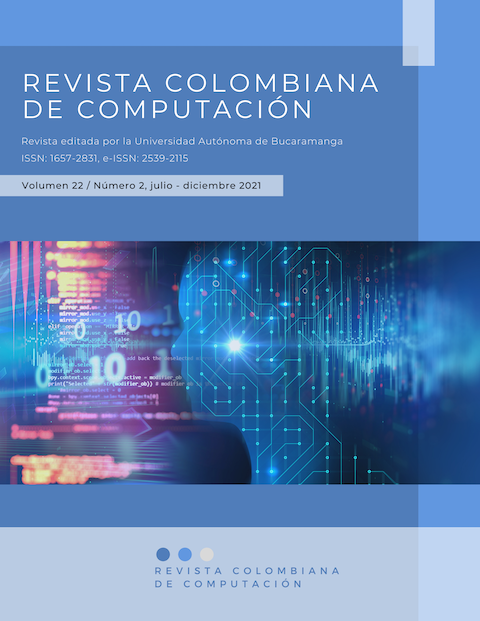Método experimental para identificar el nivel de atención en las personas
Resumen
El nivel de atención de un estudiante en su entorno escolar está relacionado con diferentes variables fisiológicas del cuerpo humano. El estudio de las señales fisiológicas relacionadas con el nivel de atención como ondas cerebrales, frecuencia cardíaca, entre otros, ha revelado grandes avances en los últimos tiempos. En este trabajo se presenta el desarrollo de un sistema para medir la atención en tiempo real y de forma cuantitativa. Las variables sensadas para poder determinar el nivel de atención del usuario son: Las ondas cerebrales tipo beta y dos ángulos que describen la postura corporal del estudiante. Se busca la correlación el porcentaje de atención que se obtiene de las ondas cerebrales, con los ángulos obtenidos de la postura corporal a través de un análisis matemático. El coeficiente de correlación resultante denota que la postura corporal puede considerarse como un parámetro que influye en el nivel de atención de los estudiantes.
Referencias bibliográficas
Anuradha, J., Tisha, Ramachandran, V., Arulalan, K. v., & Tripathy, B. K. (2010). Diagnosis of ADHD using SVM algorithm. Proceedings of the Third Annual ACM Bangalore Conference on - COMPUTE ’10. https://doi.org/10.1145/1754288.1754317
Asiry, O., Shen, H., & Calder, P. (2015, September 28). Extending Attention Span of ADHD Children through an Eye Tracker Directed Adaptive User Interface. Proceedings of the ASWEC 2015 24th Australasian Software Engineering Conference. https://doi.org/10.1145/2811681.2824997
Aymerich-Franch, L. (2012). Los juegos en entornos virtuales como herramientas de aprendizaje: estudio de la respuesta emocional de los participantes. Sphera Pública, 12, 183–197.
Bustos López, M., Hernández Montes, A. J., Vásquez Ramírez, R., Alor Hernández, G., Zatarain Cabada, R., & Barrón Estrada, M. L. (2016). EmoRemSys: Sistema de recomendación de recursos educativos basado en detección de emociones. RISTI - Revista Ibérica de Sistemas e Tecnologias de Informação, 1(17), 80–95. https://doi.org/10.17013/risti.17.80-95
Campazzo, E. N., Martínez, M., Guzmán, A. E., & Agüero, A. L. (2011). Entornos Virtuales de Aprendizaje integrado a tecnología móvil y detección de emociones. XIII Workshop de Investigadores En Ciencias de La Computación. http://sedici.unlp.edu.ar/handle/10915/19943
Campazzo, E. N., Martínez, M., Guzmán, A. E., & Agüero, A. L. (2013). Desarrollo de interface de detección de emociones para su utilización en redes sociales y entornos virtuales de aprendizaje. XV Workshop de Investigadores En Ciencias de La Computación, 973–977.
Celaya-Padilla, J., Galván-Tejada, C., López-Monteagudo, F., Alonso-González, O., Moreno-Báez, A., Martínez-Torteya, A., Galván-Tejada, J., Arceo-Olague, J., Luna-García, H., & Gamboa-Rosales, H. (2018). Speed Bump Detection Using Accelerometric Features: A Genetic Algorithm Approach. Sensors, 18(2). https://doi.org/10.3390/s18020443
Centers for Disease Control and Prevention. (2021). What is ADHD? https://www.cdc.gov/ncbddd/adhd/facts.html
Dorbessan, L., & Rodriguez, C. A. (2004). La Postura Corporal en el deporte simetrico y asimetrico.
Frutos-Pascual, M., García Zapirain, B., & Camara Buldian, K. (2014). Adaptive Cognitive Rehabilitation Interventions based on Serious Games for Children with ADHD using Biofeedback Techniques: Assessment and Evaluation. Proceedings of the 8th International Conference on Pervasive Computing Technologies for Healthcare, 321–324. https://doi.org/10.4108/icst.pervasivehealth.2014.255249
Garcia, A., Gonzalez, J. M., & Palomino, A. (2019). Data Acquisition System for the Monitoring of Attention in People and Development of Interfaces for Commercial Devices. In V. Agredo-Delgado & P. Ruiz (Eds.), Human-Computer Interaction. HCI-COLLAB 2018. Communications in Computer and Information Science (Vol. 847). Springer, Cham. https://doi.org/10.1007/978-3-030-05270-6_7
GEO Tutoriales. (2015). Cómo se relaciona el Coeficiente de Correlación de Pearson (r) y el Coeficiente de Determinación r Cuadrado (r2). https://www.gestiondeoperaciones.net/estadistica/como-se-relaciona-el-coeficiente-de-correlacion-de-pearson-r-y-el-coeficiente-de-determinacion-r-cuadrado-r%C2%B2/
Guin, A., & Bikash Baishya, B. (2013). Brain Controlled Wheelchair using LabVIEW.
Hernández-Sánchez, A. M., & Ortega, J. A. (2015). Aprendizaje Electrónico Afectivo: un modelo Innovador para Desarrollar una Acción Tutorial Virtual de Naturaleza Inclusiva. Formación Universitaria, 8(2). https://doi.org/10.4067/S0718-50062015000200004
Horii, T., Nagai, Y., & Asada, M. (2017, October 27). Active Perception based on Energy Minimization in Multimodal Human-robot Interaction. Proceedings of the 5th International Conference on Human Agent Interaction. https://doi.org/10.1145/3125739.3125757
Huh, J., & Ackerman, M. S. (2010, April 10). Exploring social dimensions of personal information management with adults with AD/HD. CHI ’10 Extended Abstracts on Human Factors in Computing Systems. https://doi.org/10.1145/1753846.1754044
Jacklyn, H. Q., & Ravichandran, S. (2009). Motivating Children with Attention Deficiency Disorder Using Certain Behavior Modification Strategies. In C. T. Lim & J. C. H. Goh (Eds.), 13th International Conference on Biomedical Engineering. IFMBE Proceedings (Vol. 23, pp. 1057–1060). Springer Berlin Heidelberg. https://doi.org/10.1007/978-3-540-92841-6
Mandryk, R. L., Dielschneider, S., Kalyn, M. R., Bertram, C. P., Gaetz, M., Doucette, A., Taylor, B. A., Orr, A. P., & Keiver, K. (2013, June 24). Games as neurofeedback training for children with FASD. Proceedings of the 12th International Conference on Interaction Design and Children. https://doi.org/10.1145/2485760.2485762
MathWorks. (2021). Data Analysis. https://es.mathworks.com/help/matlab/learn_matlab/data-analysis.html?lang=en
McLaren, E.-S., & Antle, A. N. (2017, June 27). Exploring and Evaluating Sound for Helping Children Self-Regulate with a Brain-Computer Application. Proceedings of the 2017 Conference on Interaction Design and Children. https://doi.org/10.1145/3078072.3084299
Sonne, T., Marshall, P., Obel, C., Thomsen, P. H., & Grønbæk, K. (2016). An assistive technology design framework for ADHD. Proceedings of the 28th Australian Conference on Computer-Human Interaction - OzCHI ’16. https://doi.org/10.1145/3010915.3010925
Tan, D. S., & Nijholt, A. (2010). Brain-Computer Interfaces. Applying our Minds to Human-Computer Interaction. Springer London. https://doi.org/10.1007/978-1-84996-272-8
Torres, F., Sánchez, C., & Palacios Baus, K. (2016). Adquisición y análisis de señales cerebrales utilizando el dispositivo MindWave. Maskana, 5, 83–93.
Weisberg, O., GalOz, A., Berkowitz, R., Weiss, N., Peretz, O., Azoulai, S., KoplemanRubin, D., & Zuckerman, O. (2014, June 17). TangiPlan: designing an assistive technology to enhance executive functioning among children with ADHD. Proceedings of the 2014 Conference on Interaction Design and Children. https://doi.org/10.1145/2593968.2610475
Zuckerman, O., Hoffman, G., Kopelman-Rubin, D., Klomek, A. B., Shitrit, N., Amsalem, Y., & Shlomi, Y. (2016, February 14). KIP3: Robotic Companion as an External Cue to Students with ADHD. Proceedings of the TEI ’16: Tenth International Conference on Tangible, Embedded, and Embodied Interaction. https://doi.org/10.1145/2839462.2856535
Descargas













